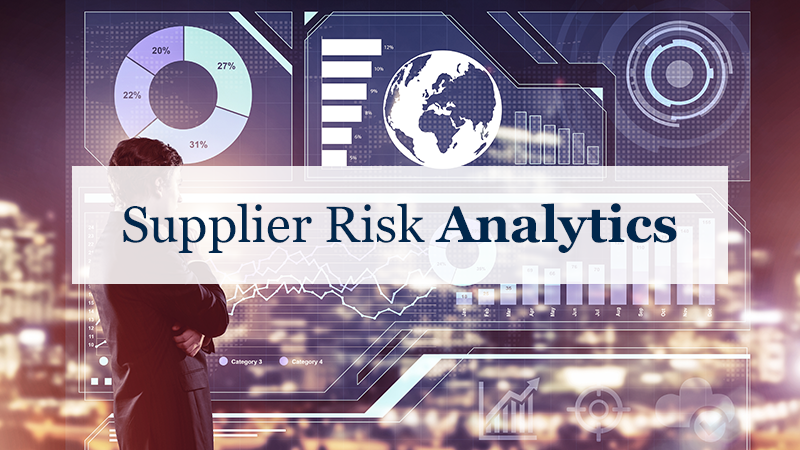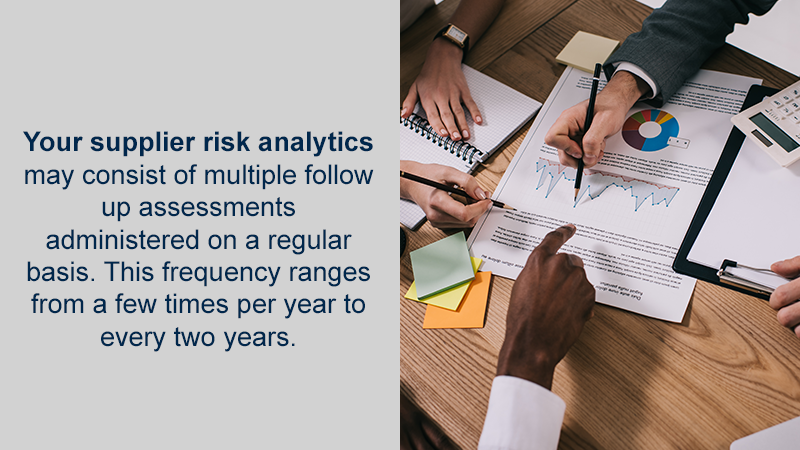Supplier Risk Analytics

Analyzing your supply chain can help streamline processes and simplify acquisitions, but it also helps identify and eliminate waste, manages cashflow and uncovers risk patterns.
Supplier Risk Analytics Defined
Supplier risk analytics is the latest means in which technology, data, risk management and decision science are combined to inform company decision-makers of opportunities to proactively mitigate risks to their supply chains posed by their suppliers.
Data from the entire spectrum of the supply chain (component supplier-to-end user) is acquired and integrated in such a way as to visualize the anticipated versus the actual flow of products through the buy-build-deliver pipeline. Early indications of deviations between anticipated product flow and actual product flow are quantified, visualized and highlighted. Mitigation planning can then occur before the risk becomes a reality.
Intangibles such as strong buyer/vendor relationships and well-defined service level agreements (SLA’s) are the bedrock upon which meaningful supplier risk analytics is built. Transparency in the form of accurate performance data from the supplier and sales forecast data from the buyer are paramount in establishing an agreed-upon and measurable baseline for product flow.
Why Analytics Proves So Vital
Although inherent, you can identify and mitigate supplier risk. You need first to assess it. This assessment involves acquiring all the necessary benchmark performance data from each supplier. This would include production capacity, internal build schedules, ship schedules, quality performance, inventory levels, continuous improvement plans and capital project schedules. Based on the analysis of the assessment results, you work with each vendor as necessary to facilitate changes that mitigate risks. Suppliers and their risks should be prioritized based on the propensity of events, the potential severity of events and the magnitude of mitigation options. Suppliers may balk, and you must pick your battles. If you determine unacceptable risk and the supplier refuses to update their methods or alter processes, you may need to find a new supplier.
Your supplier risk analytics may consist of multiple follow up assessments administered regularly. This frequency ranges from a few times per year to every two years. To the degree feasible, the supplier data analytics used to support proactive risk management should provide near real-time vitals on product flow and impending supply chain impacts.

You may find a need for an enhanced supplier and vendor diversity based on the results from your analytics program. When vendors present unacceptable risk and refuse to mitigate it, the business’s best solution remains to find a new supplier.
The higher your level of interdependency with your suppliers, the more vulnerable your business. Your supply chain should help minimize codependence. When developing your own company’s independence, you must enhance your choices and improve your knowledge to request changes from each supplier that bolster your company’s independence.
Getting Started with Supplier Risk Analytics
Developing an appropriate supplier risk management strategy requires business know-how. Going even further to acquire, integrate and leverage supplier data to mitigate supplier risks proactively requires particular expertise in the realms of data analytics, supply chain management and decision science. Starr & Associates can help you develop a solution that provides you with accurate, actionable data along with the playbook to use it. We understand the need for risk mitigation and how company interconnections influence your company’s risk mitigation.
Contact Starr & Associates today to begin developing a supply chain analytics program that puts you in control of your company’s vulnerability. Let us help move you from co-dependence to inter-dependence. You can reduce your company’s risk by assisting each vendor to reduce their vulnerability. Let us help you get started today.